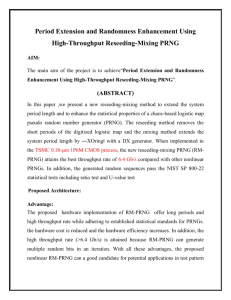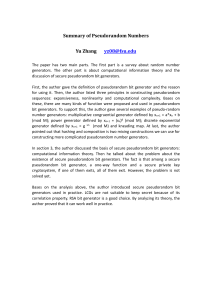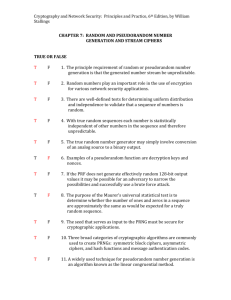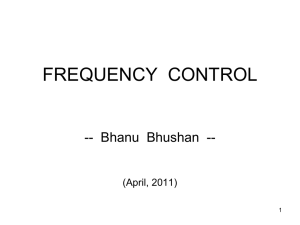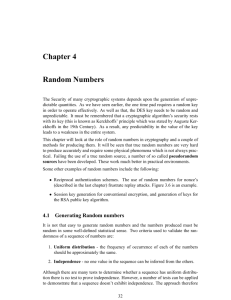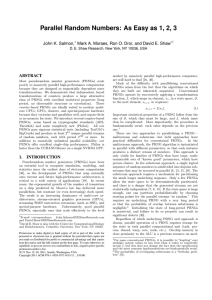Cryptographic random and pseudorandom number generators
advertisement
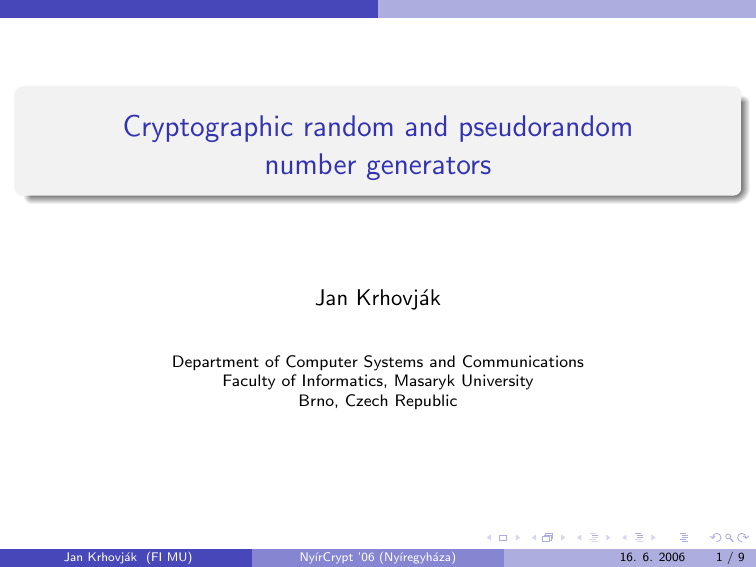
Cryptographic random and pseudorandom number generators Jan Krhovják Department of Computer Systems and Communications Faculty of Informatics, Masaryk University Brno, Czech Republic Jan Krhovják (FI MU) Nyı́rCrypt ’06 (Nyı́regyháza) 16. 6. 2006 1/9 Random number generators Introduction Outline Random and pseudorandom data in cryptography Generating truly random data I I in general purpose computer systems in mobile environments Generating pseudorandom data I I in general purpose computer systems in mobile environments Statistical testing of randomness Jan Krhovják (FI MU) Nyı́rCrypt ’06 (Nyı́regyháza) 16. 6. 2006 2/9 Random number generators Introduction Random and pseudorandom data in cryptography Random data in cryptography I I Cryptographic keys, padding values, nonces, etc. Quality and unpredictability is critical Generating truly random data I Based on nondeterministic physical phenomena I In deterministic environments extremely hard and slow F F Radioactive decay, thermal noise, etc. Only a small amount of random data in a reasonable time Generating pseudorandom data I I Typically (in many computational environments) faster Generated by deterministic algorithm F F Short input (often called seed) – truly random data Output – computationally indistinguishable from truly random data Quality of particular generators I Statistical testing & cryptanalytical methods Jan Krhovják (FI MU) Nyı́rCrypt ’06 (Nyı́regyháza) 16. 6. 2006 3/9 Random number generators Introduction Random and pseudorandom data in cryptography Random data in cryptography I I Cryptographic keys, padding values, nonces, etc. Quality and unpredictability is critical Generating truly random data I Based on nondeterministic physical phenomena I In deterministic environments extremely hard and slow F F Radioactive decay, thermal noise, etc. Only a small amount of random data in a reasonable time Generating pseudorandom data I I Typically (in many computational environments) faster Generated by deterministic algorithm F F Short input (often called seed) – truly random data Output – computationally indistinguishable from truly random data Quality of particular generators I Statistical testing & cryptanalytical methods Jan Krhovják (FI MU) Nyı́rCrypt ’06 (Nyı́regyháza) 16. 6. 2006 3/9 Random number generators Introduction Random and pseudorandom data in cryptography Random data in cryptography I I Cryptographic keys, padding values, nonces, etc. Quality and unpredictability is critical Generating truly random data I Based on nondeterministic physical phenomena I In deterministic environments extremely hard and slow F F Radioactive decay, thermal noise, etc. Only a small amount of random data in a reasonable time Generating pseudorandom data I I Typically (in many computational environments) faster Generated by deterministic algorithm F F Short input (often called seed) – truly random data Output – computationally indistinguishable from truly random data Quality of particular generators I Statistical testing & cryptanalytical methods Jan Krhovják (FI MU) Nyı́rCrypt ’06 (Nyı́regyháza) 16. 6. 2006 3/9 Random number generators Introduction Random and pseudorandom data in cryptography Random data in cryptography I I Cryptographic keys, padding values, nonces, etc. Quality and unpredictability is critical Generating truly random data I Based on nondeterministic physical phenomena I In deterministic environments extremely hard and slow F F Radioactive decay, thermal noise, etc. Only a small amount of random data in a reasonable time Generating pseudorandom data I I Typically (in many computational environments) faster Generated by deterministic algorithm F F Short input (often called seed) – truly random data Output – computationally indistinguishable from truly random data Quality of particular generators I Statistical testing & cryptanalytical methods Jan Krhovják (FI MU) Nyı́rCrypt ’06 (Nyı́regyháza) 16. 6. 2006 3/9 Random number generators Basic concepts of TRNGs Generating truly random data in computer systems Quality of TRNG is strongly dependent on source of randomness I Excellent sources – hardware-based F I Built-in on-chip (Intel) or special add-on cards (Quantis) Good sources – almost any input F F Exact timing of keystrokes or exact movements of mouse Microphone, video camera, or fluctuations in HDD access time I Acceptable sources – software-based I Bad sources – easily predictable (with insufficient entropy) F F Process, network, or I/O completion statistics System date and time, process ID, process runtime Problem of breaking or influencing TRNG I Partially solved by using digital postprocessing and statistical testing Problem of estimating entropy from particular physical event I No satisfactory solution exist Jan Krhovják (FI MU) Nyı́rCrypt ’06 (Nyı́regyháza) 16. 6. 2006 4/9 Random number generators Basic concepts of TRNGs Generating truly random data in computer systems Quality of TRNG is strongly dependent on source of randomness I Excellent sources – hardware-based F I Built-in on-chip (Intel) or special add-on cards (Quantis) Good sources – almost any input F F Exact timing of keystrokes or exact movements of mouse Microphone, video camera, or fluctuations in HDD access time I Acceptable sources – software-based I Bad sources – easily predictable (with insufficient entropy) F F Process, network, or I/O completion statistics System date and time, process ID, process runtime Problem of breaking or influencing TRNG I Partially solved by using digital postprocessing and statistical testing Problem of estimating entropy from particular physical event I No satisfactory solution exist Jan Krhovják (FI MU) Nyı́rCrypt ’06 (Nyı́regyháza) 16. 6. 2006 4/9 Random number generators Basic concepts of TRNGs Generating truly random data in computer systems Quality of TRNG is strongly dependent on source of randomness I Excellent sources – hardware-based F I Built-in on-chip (Intel) or special add-on cards (Quantis) Good sources – almost any input F F Exact timing of keystrokes or exact movements of mouse Microphone, video camera, or fluctuations in HDD access time I Acceptable sources – software-based I Bad sources – easily predictable (with insufficient entropy) F F Process, network, or I/O completion statistics System date and time, process ID, process runtime Problem of breaking or influencing TRNG I Partially solved by using digital postprocessing and statistical testing Problem of estimating entropy from particular physical event I No satisfactory solution exist Jan Krhovják (FI MU) Nyı́rCrypt ’06 (Nyı́regyháza) 16. 6. 2006 4/9 Random number generators Basic concepts of TRNGs Generating truly random data in mobile environments Considerably different mobile computational environments I I Mobile phones, personal digital assistants, cryptographic smartcards New resources of randomness (information about current location) TRNG is typically located inside the integrated chip I For many one-chip devices (such as cryptographic smartcards) it is also the only solution F I Design principles of these generators kept secret :-( Mostly based on direct amplification of a noise source, jittered oscillator sampling F Certain level of correlation due to physical limitations, influencing Statistical testing of TRNG on Gemplus GemXpresso smartcards I I Standard conditions – all selected statistical tests passed Next research – influencing generators and new tests Jan Krhovják (FI MU) Nyı́rCrypt ’06 (Nyı́regyháza) 16. 6. 2006 5/9 Random number generators Basic concepts of TRNGs Generating truly random data in mobile environments Considerably different mobile computational environments I I Mobile phones, personal digital assistants, cryptographic smartcards New resources of randomness (information about current location) TRNG is typically located inside the integrated chip I For many one-chip devices (such as cryptographic smartcards) it is also the only solution F I Design principles of these generators kept secret :-( Mostly based on direct amplification of a noise source, jittered oscillator sampling F Certain level of correlation due to physical limitations, influencing Statistical testing of TRNG on Gemplus GemXpresso smartcards I I Standard conditions – all selected statistical tests passed Next research – influencing generators and new tests Jan Krhovják (FI MU) Nyı́rCrypt ’06 (Nyı́regyháza) 16. 6. 2006 5/9 Random number generators Basic concepts of TRNGs Generating truly random data in mobile environments Considerably different mobile computational environments I I Mobile phones, personal digital assistants, cryptographic smartcards New resources of randomness (information about current location) TRNG is typically located inside the integrated chip I For many one-chip devices (such as cryptographic smartcards) it is also the only solution F I Design principles of these generators kept secret :-( Mostly based on direct amplification of a noise source, jittered oscillator sampling F Certain level of correlation due to physical limitations, influencing Statistical testing of TRNG on Gemplus GemXpresso smartcards I I Standard conditions – all selected statistical tests passed Next research – influencing generators and new tests Jan Krhovják (FI MU) Nyı́rCrypt ’06 (Nyı́regyháza) 16. 6. 2006 5/9 Random number generators Basic concepts of PRNGs Generating pseudorandom data in computer systems PRNG is deterministic finite state machine => at any point of time it is in a certain internal state I I PRNG state is secret (PRNG output must be unpredictable) PRNG (whole) state is repeatedly updated (PRNG must produce different outputs) Secret state compromise may occur – recovering is difficult I I Mixing data with small amounts of entropy to the secret state Problem is limited amount of entropy between two requests for pseudorandom data (solution is pooling) Basic types of PRNGs utilize I LFSR, hard problems of number and complexity theory, typical cryptographic functions/primitives A lot of different (and possibly unsecure) modifications of PRNGs are implemented in many applications Jan Krhovják (FI MU) Nyı́rCrypt ’06 (Nyı́regyháza) 16. 6. 2006 6/9 Random number generators Basic concepts of PRNGs Generating pseudorandom data in computer systems PRNG is deterministic finite state machine => at any point of time it is in a certain internal state I I PRNG state is secret (PRNG output must be unpredictable) PRNG (whole) state is repeatedly updated (PRNG must produce different outputs) Secret state compromise may occur – recovering is difficult I I Mixing data with small amounts of entropy to the secret state Problem is limited amount of entropy between two requests for pseudorandom data (solution is pooling) Basic types of PRNGs utilize I LFSR, hard problems of number and complexity theory, typical cryptographic functions/primitives A lot of different (and possibly unsecure) modifications of PRNGs are implemented in many applications Jan Krhovják (FI MU) Nyı́rCrypt ’06 (Nyı́regyháza) 16. 6. 2006 6/9 Random number generators Basic concepts of PRNGs Generating pseudorandom data in computer systems PRNG is deterministic finite state machine => at any point of time it is in a certain internal state I I PRNG state is secret (PRNG output must be unpredictable) PRNG (whole) state is repeatedly updated (PRNG must produce different outputs) Secret state compromise may occur – recovering is difficult I I Mixing data with small amounts of entropy to the secret state Problem is limited amount of entropy between two requests for pseudorandom data (solution is pooling) Basic types of PRNGs utilize I LFSR, hard problems of number and complexity theory, typical cryptographic functions/primitives A lot of different (and possibly unsecure) modifications of PRNGs are implemented in many applications Jan Krhovják (FI MU) Nyı́rCrypt ’06 (Nyı́regyháza) 16. 6. 2006 6/9 Random number generators Basic concepts of PRNGs Generating pseudorandom data in computer systems PRNG is deterministic finite state machine => at any point of time it is in a certain internal state I I PRNG state is secret (PRNG output must be unpredictable) PRNG (whole) state is repeatedly updated (PRNG must produce different outputs) Secret state compromise may occur – recovering is difficult I I Mixing data with small amounts of entropy to the secret state Problem is limited amount of entropy between two requests for pseudorandom data (solution is pooling) Basic types of PRNGs utilize I LFSR, hard problems of number and complexity theory, typical cryptographic functions/primitives A lot of different (and possibly unsecure) modifications of PRNGs are implemented in many applications Jan Krhovják (FI MU) Nyı́rCrypt ’06 (Nyı́regyháza) 16. 6. 2006 6/9 Random number generators Basic concepts of PRNGs Generating pseudorandom data in mobile environments Mobile environments are very different I I Lack of resources as CPU speed, memory, energy Design of PRNGs should be dependent on type of device PRNG implementations on GemXpresso JavaCards I I PRNG 1 is ANSI X9.17/31; PRNG 2 is FIPS 186-2 Very slow (see below) – inappropriate for normal use Amount of generated data after one hour GXPLite-Generic GXPPro-R3 GXP211 PK IS GXP211 PK TRNG 7973 KB 3619 KB 495 KB 492 KB PRNG 1 333 KB 151 KB 43 KB 39 KB PRNG 2 49 KB 33 KB 13 KB 13 KB All selected statistical tests also passed I Low performance of software implementations => tests only with PRNG 1 on GXPLite-Generic Jan Krhovják (FI MU) Nyı́rCrypt ’06 (Nyı́regyháza) 16. 6. 2006 7/9 Random number generators Basic concepts of PRNGs Generating pseudorandom data in mobile environments Mobile environments are very different I I Lack of resources as CPU speed, memory, energy Design of PRNGs should be dependent on type of device PRNG implementations on GemXpresso JavaCards I I PRNG 1 is ANSI X9.17/31; PRNG 2 is FIPS 186-2 Very slow (see below) – inappropriate for normal use Amount of generated data after one hour GXPLite-Generic GXPPro-R3 GXP211 PK IS GXP211 PK TRNG 7973 KB 3619 KB 495 KB 492 KB PRNG 1 333 KB 151 KB 43 KB 39 KB PRNG 2 49 KB 33 KB 13 KB 13 KB All selected statistical tests also passed I Low performance of software implementations => tests only with PRNG 1 on GXPLite-Generic Jan Krhovják (FI MU) Nyı́rCrypt ’06 (Nyı́regyháza) 16. 6. 2006 7/9 Random number generators Basic concepts of PRNGs Generating pseudorandom data in mobile environments Mobile environments are very different I I Lack of resources as CPU speed, memory, energy Design of PRNGs should be dependent on type of device PRNG implementations on GemXpresso JavaCards I I PRNG 1 is ANSI X9.17/31; PRNG 2 is FIPS 186-2 Very slow (see below) – inappropriate for normal use Amount of generated data after one hour GXPLite-Generic GXPPro-R3 GXP211 PK IS GXP211 PK TRNG 7973 KB 3619 KB 495 KB 492 KB PRNG 1 333 KB 151 KB 43 KB 39 KB PRNG 2 49 KB 33 KB 13 KB 13 KB All selected statistical tests also passed I Low performance of software implementations => tests only with PRNG 1 on GXPLite-Generic Jan Krhovják (FI MU) Nyı́rCrypt ’06 (Nyı́regyháza) 16. 6. 2006 7/9 Random number generators Basic concepts of PRNGs Generating pseudorandom data in mobile environments Mobile environments are very different I I Lack of resources as CPU speed, memory, energy Design of PRNGs should be dependent on type of device PRNG implementations on GemXpresso JavaCards I I PRNG 1 is ANSI X9.17/31; PRNG 2 is FIPS 186-2 Very slow (see below) – inappropriate for normal use Amount of generated data after one hour GXPLite-Generic GXPPro-R3 GXP211 PK IS GXP211 PK TRNG 7973 KB 3619 KB 495 KB 492 KB PRNG 1 333 KB 151 KB 43 KB 39 KB PRNG 2 49 KB 33 KB 13 KB 13 KB All selected statistical tests also passed I Low performance of software implementations => tests only with PRNG 1 on GXPLite-Generic Jan Krhovják (FI MU) Nyı́rCrypt ’06 (Nyı́regyháza) 16. 6. 2006 7/9 Random number generators Statistical testing of randomness Statistical testing of randomness Based on statistical hypothesis testing I Each statistical test is based on some function of data (test statistic) F F I No set of such tests can be considered as complete F F I Expected value of test statistic is known for the reference distribution Generated random stream is subjected to the same test Some of them are accepted as the de facto standard Well-known test batteries are NIST and DIEHARD Correct interpretation of empirical results should be very tricky NIST test battery – two approaches of evaluation results I I Examination of the proportion of sequences that pass the test Check for uniformity of the distribution of P-values F I Chi-square goodness-of-fit test If either of them fails => new experiments with different sequences We tested always 50 MB sequence divided to 100/400/800 subsequences with level of significance 0.01 Jan Krhovják (FI MU) Nyı́rCrypt ’06 (Nyı́regyháza) 16. 6. 2006 8/9 Random number generators Statistical testing of randomness Statistical testing of randomness Based on statistical hypothesis testing I Each statistical test is based on some function of data (test statistic) F F I No set of such tests can be considered as complete F F I Expected value of test statistic is known for the reference distribution Generated random stream is subjected to the same test Some of them are accepted as the de facto standard Well-known test batteries are NIST and DIEHARD Correct interpretation of empirical results should be very tricky NIST test battery – two approaches of evaluation results I I Examination of the proportion of sequences that pass the test Check for uniformity of the distribution of P-values F I Chi-square goodness-of-fit test If either of them fails => new experiments with different sequences We tested always 50 MB sequence divided to 100/400/800 subsequences with level of significance 0.01 Jan Krhovják (FI MU) Nyı́rCrypt ’06 (Nyı́regyháza) 16. 6. 2006 8/9 Random number generators Statistical testing of randomness Statistical testing of randomness Based on statistical hypothesis testing I Each statistical test is based on some function of data (test statistic) F F I No set of such tests can be considered as complete F F I Expected value of test statistic is known for the reference distribution Generated random stream is subjected to the same test Some of them are accepted as the de facto standard Well-known test batteries are NIST and DIEHARD Correct interpretation of empirical results should be very tricky NIST test battery – two approaches of evaluation results I I Examination of the proportion of sequences that pass the test Check for uniformity of the distribution of P-values F I Chi-square goodness-of-fit test If either of them fails => new experiments with different sequences We tested always 50 MB sequence divided to 100/400/800 subsequences with level of significance 0.01 Jan Krhovják (FI MU) Nyı́rCrypt ’06 (Nyı́regyháza) 16. 6. 2006 8/9 Random number generators Conclusion Conclusion Generators of random and pseudorandom data in cryptography I I Acceptable designs in general purpose computer systems Situation is more serious in mobile environments Three basic areas of our research (focused on mobile environments) I Identification and analysis of new sources of randomness I Design of principles of new pseudorandom number generators F F I Information about location, signal characteristics, etc. With respect to particular mobile environments Design/modification of password-based cryptographic protocols Jan Krhovják (FI MU) Nyı́rCrypt ’06 (Nyı́regyháza) 16. 6. 2006 9/9 Random number generators Conclusion Conclusion Generators of random and pseudorandom data in cryptography I I Acceptable designs in general purpose computer systems Situation is more serious in mobile environments Three basic areas of our research (focused on mobile environments) I Identification and analysis of new sources of randomness I Design of principles of new pseudorandom number generators F F I Information about location, signal characteristics, etc. With respect to particular mobile environments Design/modification of password-based cryptographic protocols Jan Krhovják (FI MU) Nyı́rCrypt ’06 (Nyı́regyháza) 16. 6. 2006 9/9
